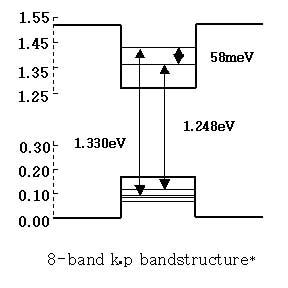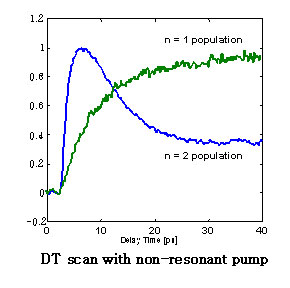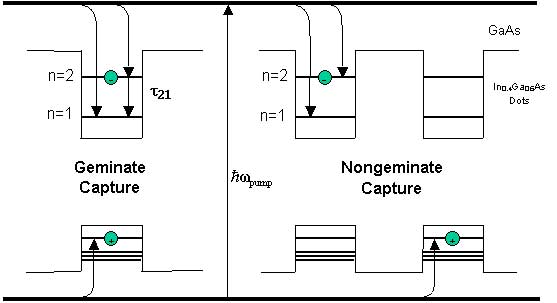Ultrafast Non-degenerate Pump-Probe Spectroscopy of the Carrier Transport in Semiconductor Self-Organized Quantum Dots
Semiconductor self-organized quantum-dots (QD) exhibit strong three dimensional carrier confinement and show discrete energy spectra; i.e. in many ways they are like artificial atoms. Compared to the atoms which can be captured by sophisticated cooling and trapping technique for a limited time, semiconductor QD’s are structurally robust and improved by industrial base for semiconductor processing. The specific quantum dots being investigated by our group are grown in Prof. Bhattacharya’s lab here at Michigan using the Stranski-Krastanow growth mode; this utilizes the strain caused by the lattice mismatch between the QD layer and the substrate during MBE (Molecular Beam Epitaxy) to form QD islands which are in the shape of a pyramid, with a height of 7 nm and a base size of 14 nm.[1]


QD devices are being considered for a wide variety of applications, including diode lasers, semiconductor optical amplifiers, infrared detectors, mid-IR lasers, and quantum-optical single-photon emitters. For all of these devices, the capture and relaxation of electrons and holes between the confined electronic states in the dots are critical processes governing the operation of the device. Therefore, our group is engaged in a broad effort to study the carrier dynamics on these structures. Our approach is to use ultrafast non-degenerate white-light pump and probe spectroscopy, using a 250 kHz Ti:Sapphire regenerative amplifier system developed in our laboratory several years ago [2].


Recent investigations of carrier relaxation dynamics in self-organized QD’s have revealed that at low carrier density, the relaxation of geminately captured electrons and holes occurs on picosecond time-scale due to Coulomb scattering [3] and sub-picosecond interdot electronic tunneling in vertically coupled In0.4Ga0.6As QD’s [4]; however, non-geminately captured electrons relax are trapped in the dot excited state by a phonon-bottleneck[5]; if the energy level spacings are sufficiently large, then the rate of phonon-mediated scattering is inhibited because energy and momentum conservation forbids transitions mediated by a single phonon emission. The key to this observation is the generation of electrons in dots where there are no holes so that electron-hole scattering does not mask the bottleneck. This is accomplished by using a very low density of photo-injected carriers, such that the probability of non-geminate capture into the dots becomes significant.

For an understanding of laser modulation dynamics, it is necessary to consider carrier dynamics at a high carrier density, under a population inversion. Using a three-pulse pump-probe technique, we have investigated spectral hole-burning and the gain recovery dynamics in In(Ga)As QD’s [6]. The gain recovery due to Auger-dominated intradot relaxation is found to be very fast (~100 fs), indicating that this is not the factor limiting the bandwidth of directly modulated QD lasers.
References
[1] P. Bhattacharya, K. K. Kamath, J. Singh, D. Klotzkin, J. Phillips, H. Jiang, N. Chervela, T. B. Norris, T. Sosnowski, J. Laskar, M. R. Murty, “In(Ga)As/GaAs self-organized quantum dot lasers: DC and small-signal modulation properties”, IEEE Trans. Electron Devices, 46, 871 (1999)
[2] T. K. Rhee, T. S. Sosnowski, T. B. Norris, J. A. Arns, W. S. Colburn, “Chirped-pulse amplification of 85-fs pulses at 250kHz with 3rd-order dispersion compensation by use of holographic transmission gratings”, Opt. Lett. 19, 1550 (1994)
[3] T. S. Sosnowski, T. B. Norris, H. Jiang, J. Singh, K. Kamath, and P. Bhattacharya, “Rapid carrier relaxation in In0.4Ga0.6As/GaAs quantum dots characterized by differential transmission spectroscopy”, Phys. Rev. B, 57, R9423 (1998)
[4] J. Urayama, T. B. Norris, B. Kochman, J. Singh, P. Bhattacharya, “Evidence of interdot electronic tunneling in vertically coupled In0.4Ga0.6As self-organized quantum dots”, Appl. Phys. Lett. 76, 2394 (2000)
[5] J. Urayama, T. B. Norris, J. Singh, P. Bhattacharya, “Observation of phonon bottleneck in quantum dot electronic relaxation”, Phys. Rev. Lett. 86, 4930 (2001)
[6] K. Kim, J. Urayama, T. B. Norris, J. Singh, J. Phillips, and P. Bhattacharya, “Gain dynamics and ultrafast spectral hole-burning in In(Ga)As self-organized quantum dots”, To be submitted to Appl. Phys. Lett.
 MENU
MENU